Psychology Assignment: Mental and Behavioral Disorder Classification
VerifiedAdded on 2022/12/26
|12
|3108
|61
Report
AI Summary
This report provides a comprehensive overview of mental and behavioral disorders, beginning with an introduction that highlights the prevalence of psychological illnesses in various age groups, referencing data from the U.S. Branch of Health and Human Services and the Centers for Disease Control and Prevention. It then delves into the historical and contemporary support systems, treatments, and provisions available for individuals facing mental health challenges, discussing conditions like depression, bipolar disorder, schizophrenia, dementia, and chronic problems. The report examines the classification and diagnosis of mental disorders as specified in the ICD-10 from the World Health Organization, comparing it to the DSM-IV. It addresses the complexities of diagnosis, particularly in cases of pain disorders, and concludes by emphasizing the importance of mental health support and the need for improved care, especially in low- and middle-income countries. The report underscores the WHO's Mental Health Action Plan and the mhGAP program, which aim to enhance mental health services globally.

Classification of Mental and Behavioral
Disorders
Disorders
Paraphrase This Document
Need a fresh take? Get an instant paraphrase of this document with our AI Paraphraser

Table of Contents
Introduction......................................................................................................................................3
Historical and contemporary support, treatment and provisions for those living with mental ill
health or mental disorders................................................................................................................3
Classification and diagnosis of mental disorders as specified in the ICD (2010) from the World
Health Organization.........................................................................................................................7
Conclude........................................................................................................................................11
References......................................................................................................................................12
Introduction......................................................................................................................................3
Historical and contemporary support, treatment and provisions for those living with mental ill
health or mental disorders................................................................................................................3
Classification and diagnosis of mental disorders as specified in the ICD (2010) from the World
Health Organization.........................................................................................................................7
Conclude........................................................................................................................................11
References......................................................................................................................................12
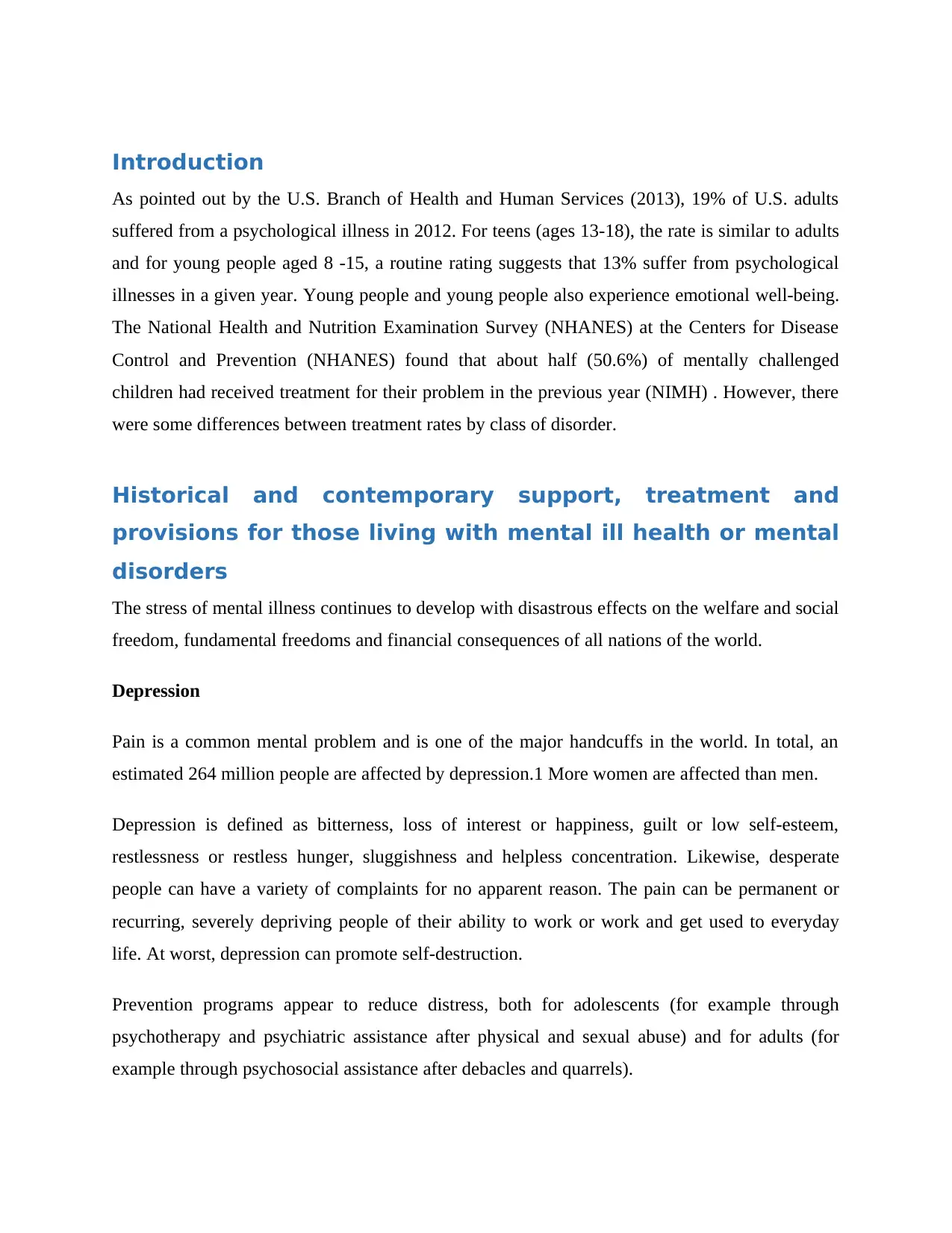
Introduction
As pointed out by the U.S. Branch of Health and Human Services (2013), 19% of U.S. adults
suffered from a psychological illness in 2012. For teens (ages 13-18), the rate is similar to adults
and for young people aged 8 -15, a routine rating suggests that 13% suffer from psychological
illnesses in a given year. Young people and young people also experience emotional well-being.
The National Health and Nutrition Examination Survey (NHANES) at the Centers for Disease
Control and Prevention (NHANES) found that about half (50.6%) of mentally challenged
children had received treatment for their problem in the previous year (NIMH) . However, there
were some differences between treatment rates by class of disorder.
Historical and contemporary support, treatment and
provisions for those living with mental ill health or mental
disorders
The stress of mental illness continues to develop with disastrous effects on the welfare and social
freedom, fundamental freedoms and financial consequences of all nations of the world.
Depression
Pain is a common mental problem and is one of the major handcuffs in the world. In total, an
estimated 264 million people are affected by depression.1 More women are affected than men.
Depression is defined as bitterness, loss of interest or happiness, guilt or low self-esteem,
restlessness or restless hunger, sluggishness and helpless concentration. Likewise, desperate
people can have a variety of complaints for no apparent reason. The pain can be permanent or
recurring, severely depriving people of their ability to work or work and get used to everyday
life. At worst, depression can promote self-destruction.
Prevention programs appear to reduce distress, both for adolescents (for example through
psychotherapy and psychiatric assistance after physical and sexual abuse) and for adults (for
example through psychosocial assistance after debacles and quarrels).
As pointed out by the U.S. Branch of Health and Human Services (2013), 19% of U.S. adults
suffered from a psychological illness in 2012. For teens (ages 13-18), the rate is similar to adults
and for young people aged 8 -15, a routine rating suggests that 13% suffer from psychological
illnesses in a given year. Young people and young people also experience emotional well-being.
The National Health and Nutrition Examination Survey (NHANES) at the Centers for Disease
Control and Prevention (NHANES) found that about half (50.6%) of mentally challenged
children had received treatment for their problem in the previous year (NIMH) . However, there
were some differences between treatment rates by class of disorder.
Historical and contemporary support, treatment and
provisions for those living with mental ill health or mental
disorders
The stress of mental illness continues to develop with disastrous effects on the welfare and social
freedom, fundamental freedoms and financial consequences of all nations of the world.
Depression
Pain is a common mental problem and is one of the major handcuffs in the world. In total, an
estimated 264 million people are affected by depression.1 More women are affected than men.
Depression is defined as bitterness, loss of interest or happiness, guilt or low self-esteem,
restlessness or restless hunger, sluggishness and helpless concentration. Likewise, desperate
people can have a variety of complaints for no apparent reason. The pain can be permanent or
recurring, severely depriving people of their ability to work or work and get used to everyday
life. At worst, depression can promote self-destruction.
Prevention programs appear to reduce distress, both for adolescents (for example through
psychotherapy and psychiatric assistance after physical and sexual abuse) and for adults (for
example through psychosocial assistance after debacles and quarrels).
⊘ This is a preview!⊘
Do you want full access?
Subscribe today to unlock all pages.

Trusted by 1+ million students worldwide

There are also powerful drugs. Depression can be gently treated directly with verbal therapies,
such as intellectual behavior treatment or psychotherapy. Antidepressants can be a powerful
form of treatment for moderate to severe depression, but they are not the main line of treatment
for examples of mild depression. They should not be used for the treatment of depression in
adolescents and do not represent the first line of treatment in a timely manner, even with caution.
The pain committee should consider psychosocial attitudes, including identifying stressors, such
as financial problems, work difficulties, or physical or mental abuse, and sources of help, such as
relatives and peers. It is important to maintain or revitalize informal communities and social
exercises.
Bipolar disorder
This problem affects approximately 45 million people worldwide1. It regularly features both
hyper and heavy scenes, isolated from normal mental moments. Hyper scenes include elevated or
touchy temper, too much movement, quick speech, more confidence, and less need for rest.
Individuals who have depressive episodes but do not come across heavy-sightedness are also
reported to have bipolar disorder.
Controversial drugs are available to treat the acute period of bipolar disorder and to avoid
relapse. These are commands that release the feeling. Psychosocial support is an important part
of treatment.
Schizophrenia and various mental disorders
Schizophrenia is a serious mental illness, affecting 20 million people worldwide1. Psychoses,
including schizophrenia, are represented by contortions in reasoning, judgment, emotions,
language, self-esteem and behavior. Ordinary subtle meetings involve images (hearing, seeing or
hearing things that are not there) and fantasies (fixed delusions or doubts that are firmly held in
any situation, when there is evidence of despite what you might expect). The problem can be
difficult for those affected by regular work or concentration.
such as intellectual behavior treatment or psychotherapy. Antidepressants can be a powerful
form of treatment for moderate to severe depression, but they are not the main line of treatment
for examples of mild depression. They should not be used for the treatment of depression in
adolescents and do not represent the first line of treatment in a timely manner, even with caution.
The pain committee should consider psychosocial attitudes, including identifying stressors, such
as financial problems, work difficulties, or physical or mental abuse, and sources of help, such as
relatives and peers. It is important to maintain or revitalize informal communities and social
exercises.
Bipolar disorder
This problem affects approximately 45 million people worldwide1. It regularly features both
hyper and heavy scenes, isolated from normal mental moments. Hyper scenes include elevated or
touchy temper, too much movement, quick speech, more confidence, and less need for rest.
Individuals who have depressive episodes but do not come across heavy-sightedness are also
reported to have bipolar disorder.
Controversial drugs are available to treat the acute period of bipolar disorder and to avoid
relapse. These are commands that release the feeling. Psychosocial support is an important part
of treatment.
Schizophrenia and various mental disorders
Schizophrenia is a serious mental illness, affecting 20 million people worldwide1. Psychoses,
including schizophrenia, are represented by contortions in reasoning, judgment, emotions,
language, self-esteem and behavior. Ordinary subtle meetings involve images (hearing, seeing or
hearing things that are not there) and fantasies (fixed delusions or doubts that are firmly held in
any situation, when there is evidence of despite what you might expect). The problem can be
difficult for those affected by regular work or concentration.
Paraphrase This Document
Need a fresh take? Get an instant paraphrase of this document with our AI Paraphraser
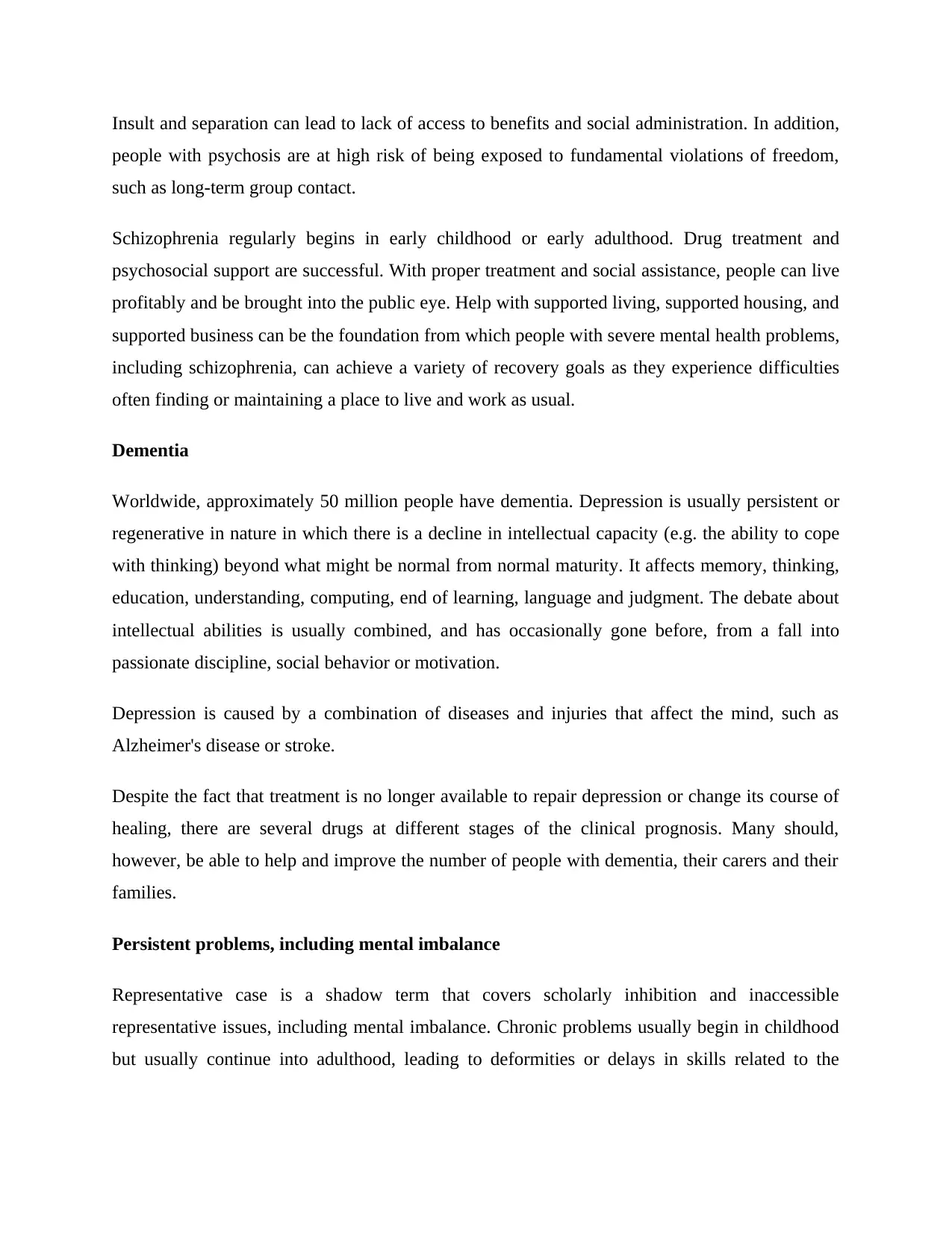
Insult and separation can lead to lack of access to benefits and social administration. In addition,
people with psychosis are at high risk of being exposed to fundamental violations of freedom,
such as long-term group contact.
Schizophrenia regularly begins in early childhood or early adulthood. Drug treatment and
psychosocial support are successful. With proper treatment and social assistance, people can live
profitably and be brought into the public eye. Help with supported living, supported housing, and
supported business can be the foundation from which people with severe mental health problems,
including schizophrenia, can achieve a variety of recovery goals as they experience difficulties
often finding or maintaining a place to live and work as usual.
Dementia
Worldwide, approximately 50 million people have dementia. Depression is usually persistent or
regenerative in nature in which there is a decline in intellectual capacity (e.g. the ability to cope
with thinking) beyond what might be normal from normal maturity. It affects memory, thinking,
education, understanding, computing, end of learning, language and judgment. The debate about
intellectual abilities is usually combined, and has occasionally gone before, from a fall into
passionate discipline, social behavior or motivation.
Depression is caused by a combination of diseases and injuries that affect the mind, such as
Alzheimer's disease or stroke.
Despite the fact that treatment is no longer available to repair depression or change its course of
healing, there are several drugs at different stages of the clinical prognosis. Many should,
however, be able to help and improve the number of people with dementia, their carers and their
families.
Persistent problems, including mental imbalance
Representative case is a shadow term that covers scholarly inhibition and inaccessible
representative issues, including mental imbalance. Chronic problems usually begin in childhood
but usually continue into adulthood, leading to deformities or delays in skills related to the
people with psychosis are at high risk of being exposed to fundamental violations of freedom,
such as long-term group contact.
Schizophrenia regularly begins in early childhood or early adulthood. Drug treatment and
psychosocial support are successful. With proper treatment and social assistance, people can live
profitably and be brought into the public eye. Help with supported living, supported housing, and
supported business can be the foundation from which people with severe mental health problems,
including schizophrenia, can achieve a variety of recovery goals as they experience difficulties
often finding or maintaining a place to live and work as usual.
Dementia
Worldwide, approximately 50 million people have dementia. Depression is usually persistent or
regenerative in nature in which there is a decline in intellectual capacity (e.g. the ability to cope
with thinking) beyond what might be normal from normal maturity. It affects memory, thinking,
education, understanding, computing, end of learning, language and judgment. The debate about
intellectual abilities is usually combined, and has occasionally gone before, from a fall into
passionate discipline, social behavior or motivation.
Depression is caused by a combination of diseases and injuries that affect the mind, such as
Alzheimer's disease or stroke.
Despite the fact that treatment is no longer available to repair depression or change its course of
healing, there are several drugs at different stages of the clinical prognosis. Many should,
however, be able to help and improve the number of people with dementia, their carers and their
families.
Persistent problems, including mental imbalance
Representative case is a shadow term that covers scholarly inhibition and inaccessible
representative issues, including mental imbalance. Chronic problems usually begin in childhood
but usually continue into adulthood, leading to deformities or delays in skills related to the
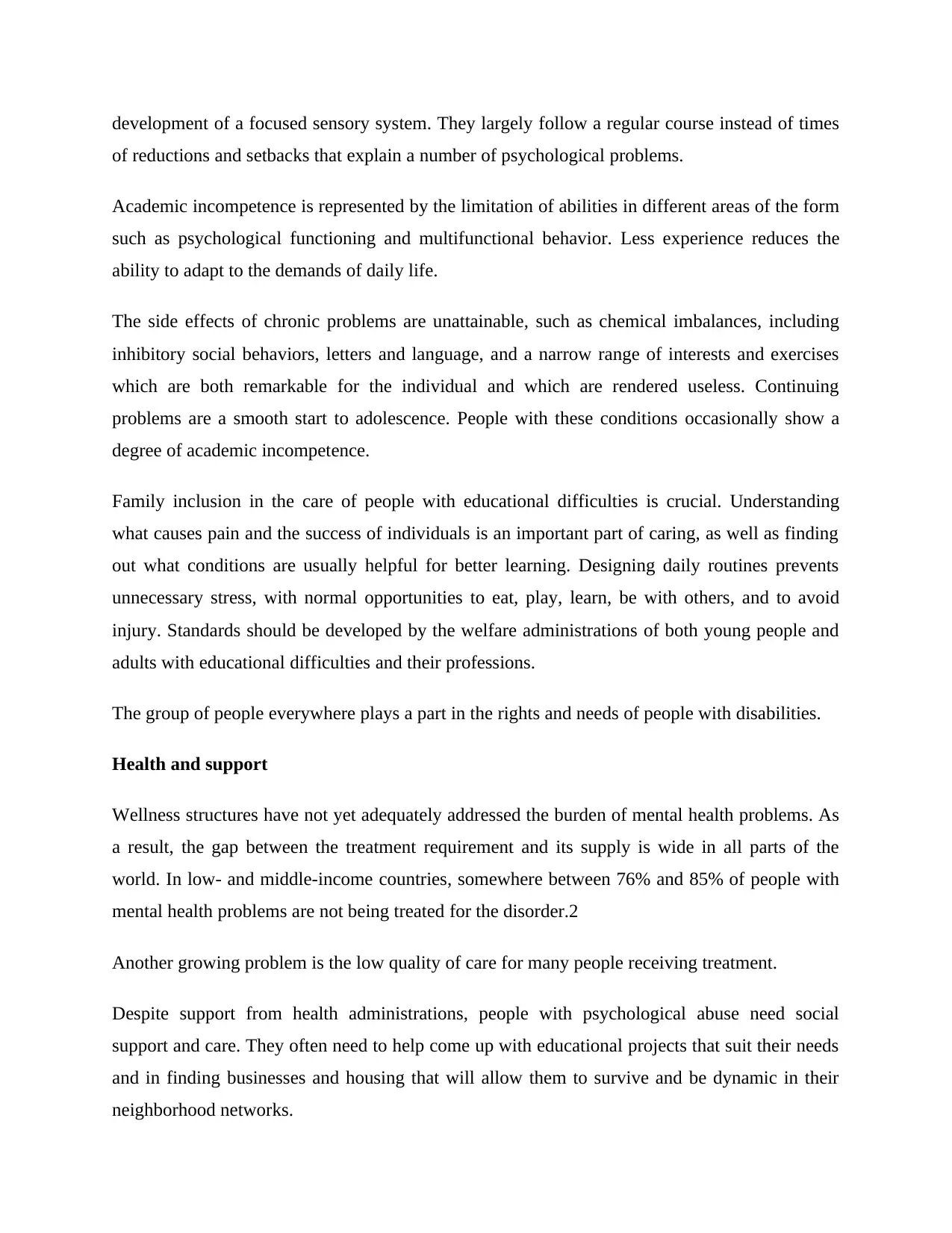
development of a focused sensory system. They largely follow a regular course instead of times
of reductions and setbacks that explain a number of psychological problems.
Academic incompetence is represented by the limitation of abilities in different areas of the form
such as psychological functioning and multifunctional behavior. Less experience reduces the
ability to adapt to the demands of daily life.
The side effects of chronic problems are unattainable, such as chemical imbalances, including
inhibitory social behaviors, letters and language, and a narrow range of interests and exercises
which are both remarkable for the individual and which are rendered useless. Continuing
problems are a smooth start to adolescence. People with these conditions occasionally show a
degree of academic incompetence.
Family inclusion in the care of people with educational difficulties is crucial. Understanding
what causes pain and the success of individuals is an important part of caring, as well as finding
out what conditions are usually helpful for better learning. Designing daily routines prevents
unnecessary stress, with normal opportunities to eat, play, learn, be with others, and to avoid
injury. Standards should be developed by the welfare administrations of both young people and
adults with educational difficulties and their professions.
The group of people everywhere plays a part in the rights and needs of people with disabilities.
Health and support
Wellness structures have not yet adequately addressed the burden of mental health problems. As
a result, the gap between the treatment requirement and its supply is wide in all parts of the
world. In low- and middle-income countries, somewhere between 76% and 85% of people with
mental health problems are not being treated for the disorder.2
Another growing problem is the low quality of care for many people receiving treatment.
Despite support from health administrations, people with psychological abuse need social
support and care. They often need to help come up with educational projects that suit their needs
and in finding businesses and housing that will allow them to survive and be dynamic in their
neighborhood networks.
of reductions and setbacks that explain a number of psychological problems.
Academic incompetence is represented by the limitation of abilities in different areas of the form
such as psychological functioning and multifunctional behavior. Less experience reduces the
ability to adapt to the demands of daily life.
The side effects of chronic problems are unattainable, such as chemical imbalances, including
inhibitory social behaviors, letters and language, and a narrow range of interests and exercises
which are both remarkable for the individual and which are rendered useless. Continuing
problems are a smooth start to adolescence. People with these conditions occasionally show a
degree of academic incompetence.
Family inclusion in the care of people with educational difficulties is crucial. Understanding
what causes pain and the success of individuals is an important part of caring, as well as finding
out what conditions are usually helpful for better learning. Designing daily routines prevents
unnecessary stress, with normal opportunities to eat, play, learn, be with others, and to avoid
injury. Standards should be developed by the welfare administrations of both young people and
adults with educational difficulties and their professions.
The group of people everywhere plays a part in the rights and needs of people with disabilities.
Health and support
Wellness structures have not yet adequately addressed the burden of mental health problems. As
a result, the gap between the treatment requirement and its supply is wide in all parts of the
world. In low- and middle-income countries, somewhere between 76% and 85% of people with
mental health problems are not being treated for the disorder.2
Another growing problem is the low quality of care for many people receiving treatment.
Despite support from health administrations, people with psychological abuse need social
support and care. They often need to help come up with educational projects that suit their needs
and in finding businesses and housing that will allow them to survive and be dynamic in their
neighborhood networks.
⊘ This is a preview!⊘
Do you want full access?
Subscribe today to unlock all pages.

Trusted by 1+ million students worldwide
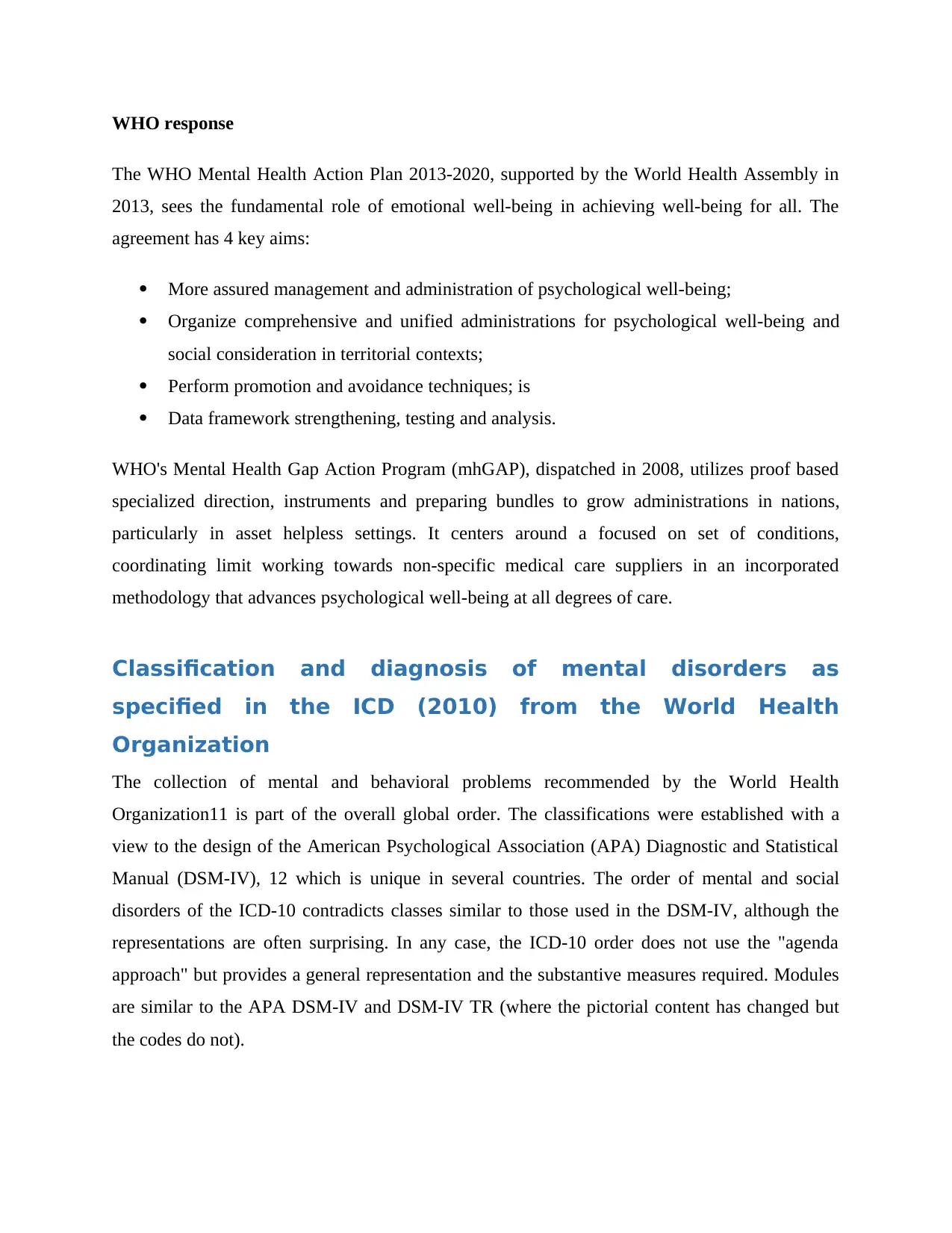
WHO response
The WHO Mental Health Action Plan 2013-2020, supported by the World Health Assembly in
2013, sees the fundamental role of emotional well-being in achieving well-being for all. The
agreement has 4 key aims:
More assured management and administration of psychological well-being;
Organize comprehensive and unified administrations for psychological well-being and
social consideration in territorial contexts;
Perform promotion and avoidance techniques; is
Data framework strengthening, testing and analysis.
WHO's Mental Health Gap Action Program (mhGAP), dispatched in 2008, utilizes proof based
specialized direction, instruments and preparing bundles to grow administrations in nations,
particularly in asset helpless settings. It centers around a focused on set of conditions,
coordinating limit working towards non-specific medical care suppliers in an incorporated
methodology that advances psychological well-being at all degrees of care.
Classification and diagnosis of mental disorders as
specified in the ICD (2010) from the World Health
Organization
The collection of mental and behavioral problems recommended by the World Health
Organization11 is part of the overall global order. The classifications were established with a
view to the design of the American Psychological Association (APA) Diagnostic and Statistical
Manual (DSM-IV), 12 which is unique in several countries. The order of mental and social
disorders of the ICD-10 contradicts classes similar to those used in the DSM-IV, although the
representations are often surprising. In any case, the ICD-10 order does not use the "agenda
approach" but provides a general representation and the substantive measures required. Modules
are similar to the APA DSM-IV and DSM-IV TR (where the pictorial content has changed but
the codes do not).
The WHO Mental Health Action Plan 2013-2020, supported by the World Health Assembly in
2013, sees the fundamental role of emotional well-being in achieving well-being for all. The
agreement has 4 key aims:
More assured management and administration of psychological well-being;
Organize comprehensive and unified administrations for psychological well-being and
social consideration in territorial contexts;
Perform promotion and avoidance techniques; is
Data framework strengthening, testing and analysis.
WHO's Mental Health Gap Action Program (mhGAP), dispatched in 2008, utilizes proof based
specialized direction, instruments and preparing bundles to grow administrations in nations,
particularly in asset helpless settings. It centers around a focused on set of conditions,
coordinating limit working towards non-specific medical care suppliers in an incorporated
methodology that advances psychological well-being at all degrees of care.
Classification and diagnosis of mental disorders as
specified in the ICD (2010) from the World Health
Organization
The collection of mental and behavioral problems recommended by the World Health
Organization11 is part of the overall global order. The classifications were established with a
view to the design of the American Psychological Association (APA) Diagnostic and Statistical
Manual (DSM-IV), 12 which is unique in several countries. The order of mental and social
disorders of the ICD-10 contradicts classes similar to those used in the DSM-IV, although the
representations are often surprising. In any case, the ICD-10 order does not use the "agenda
approach" but provides a general representation and the substantive measures required. Modules
are similar to the APA DSM-IV and DSM-IV TR (where the pictorial content has changed but
the codes do not).
Paraphrase This Document
Need a fresh take? Get an instant paraphrase of this document with our AI Paraphraser
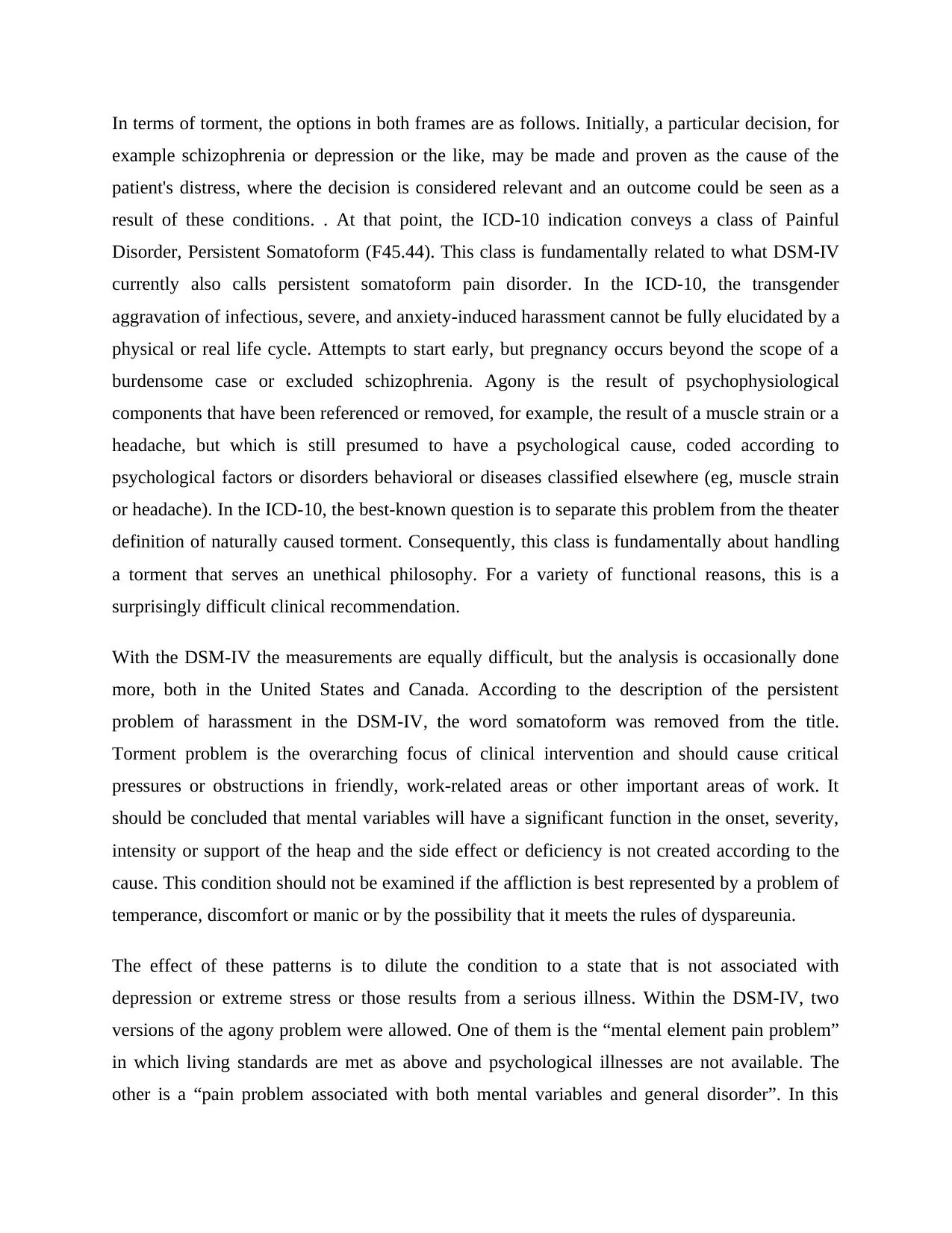
In terms of torment, the options in both frames are as follows. Initially, a particular decision, for
example schizophrenia or depression or the like, may be made and proven as the cause of the
patient's distress, where the decision is considered relevant and an outcome could be seen as a
result of these conditions. . At that point, the ICD-10 indication conveys a class of Painful
Disorder, Persistent Somatoform (F45.44). This class is fundamentally related to what DSM-IV
currently also calls persistent somatoform pain disorder. In the ICD-10, the transgender
aggravation of infectious, severe, and anxiety-induced harassment cannot be fully elucidated by a
physical or real life cycle. Attempts to start early, but pregnancy occurs beyond the scope of a
burdensome case or excluded schizophrenia. Agony is the result of psychophysiological
components that have been referenced or removed, for example, the result of a muscle strain or a
headache, but which is still presumed to have a psychological cause, coded according to
psychological factors or disorders behavioral or diseases classified elsewhere (eg, muscle strain
or headache). In the ICD-10, the best-known question is to separate this problem from the theater
definition of naturally caused torment. Consequently, this class is fundamentally about handling
a torment that serves an unethical philosophy. For a variety of functional reasons, this is a
surprisingly difficult clinical recommendation.
With the DSM-IV the measurements are equally difficult, but the analysis is occasionally done
more, both in the United States and Canada. According to the description of the persistent
problem of harassment in the DSM-IV, the word somatoform was removed from the title.
Torment problem is the overarching focus of clinical intervention and should cause critical
pressures or obstructions in friendly, work-related areas or other important areas of work. It
should be concluded that mental variables will have a significant function in the onset, severity,
intensity or support of the heap and the side effect or deficiency is not created according to the
cause. This condition should not be examined if the affliction is best represented by a problem of
temperance, discomfort or manic or by the possibility that it meets the rules of dyspareunia.
The effect of these patterns is to dilute the condition to a state that is not associated with
depression or extreme stress or those results from a serious illness. Within the DSM-IV, two
versions of the agony problem were allowed. One of them is the “mental element pain problem”
in which living standards are met as above and psychological illnesses are not available. The
other is a “pain problem associated with both mental variables and general disorder”. In this
example schizophrenia or depression or the like, may be made and proven as the cause of the
patient's distress, where the decision is considered relevant and an outcome could be seen as a
result of these conditions. . At that point, the ICD-10 indication conveys a class of Painful
Disorder, Persistent Somatoform (F45.44). This class is fundamentally related to what DSM-IV
currently also calls persistent somatoform pain disorder. In the ICD-10, the transgender
aggravation of infectious, severe, and anxiety-induced harassment cannot be fully elucidated by a
physical or real life cycle. Attempts to start early, but pregnancy occurs beyond the scope of a
burdensome case or excluded schizophrenia. Agony is the result of psychophysiological
components that have been referenced or removed, for example, the result of a muscle strain or a
headache, but which is still presumed to have a psychological cause, coded according to
psychological factors or disorders behavioral or diseases classified elsewhere (eg, muscle strain
or headache). In the ICD-10, the best-known question is to separate this problem from the theater
definition of naturally caused torment. Consequently, this class is fundamentally about handling
a torment that serves an unethical philosophy. For a variety of functional reasons, this is a
surprisingly difficult clinical recommendation.
With the DSM-IV the measurements are equally difficult, but the analysis is occasionally done
more, both in the United States and Canada. According to the description of the persistent
problem of harassment in the DSM-IV, the word somatoform was removed from the title.
Torment problem is the overarching focus of clinical intervention and should cause critical
pressures or obstructions in friendly, work-related areas or other important areas of work. It
should be concluded that mental variables will have a significant function in the onset, severity,
intensity or support of the heap and the side effect or deficiency is not created according to the
cause. This condition should not be examined if the affliction is best represented by a problem of
temperance, discomfort or manic or by the possibility that it meets the rules of dyspareunia.
The effect of these patterns is to dilute the condition to a state that is not associated with
depression or extreme stress or those results from a serious illness. Within the DSM-IV, two
versions of the agony problem were allowed. One of them is the “mental element pain problem”
in which living standards are met as above and psychological illnesses are not available. The
other is a “pain problem associated with both mental variables and general disorder”. In this
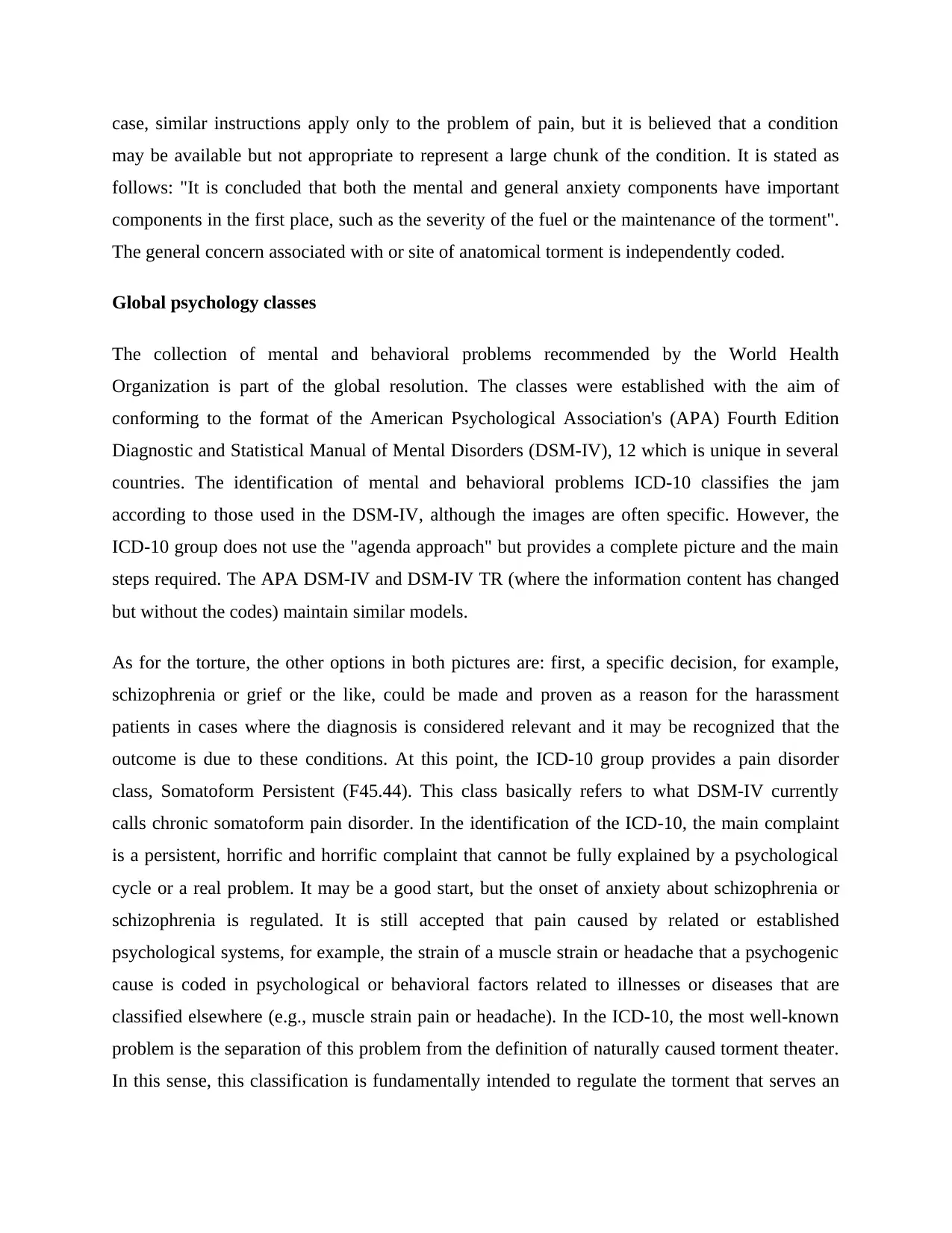
case, similar instructions apply only to the problem of pain, but it is believed that a condition
may be available but not appropriate to represent a large chunk of the condition. It is stated as
follows: "It is concluded that both the mental and general anxiety components have important
components in the first place, such as the severity of the fuel or the maintenance of the torment".
The general concern associated with or site of anatomical torment is independently coded.
Global psychology classes
The collection of mental and behavioral problems recommended by the World Health
Organization is part of the global resolution. The classes were established with the aim of
conforming to the format of the American Psychological Association's (APA) Fourth Edition
Diagnostic and Statistical Manual of Mental Disorders (DSM-IV), 12 which is unique in several
countries. The identification of mental and behavioral problems ICD-10 classifies the jam
according to those used in the DSM-IV, although the images are often specific. However, the
ICD-10 group does not use the "agenda approach" but provides a complete picture and the main
steps required. The APA DSM-IV and DSM-IV TR (where the information content has changed
but without the codes) maintain similar models.
As for the torture, the other options in both pictures are: first, a specific decision, for example,
schizophrenia or grief or the like, could be made and proven as a reason for the harassment
patients in cases where the diagnosis is considered relevant and it may be recognized that the
outcome is due to these conditions. At this point, the ICD-10 group provides a pain disorder
class, Somatoform Persistent (F45.44). This class basically refers to what DSM-IV currently
calls chronic somatoform pain disorder. In the identification of the ICD-10, the main complaint
is a persistent, horrific and horrific complaint that cannot be fully explained by a psychological
cycle or a real problem. It may be a good start, but the onset of anxiety about schizophrenia or
schizophrenia is regulated. It is still accepted that pain caused by related or established
psychological systems, for example, the strain of a muscle strain or headache that a psychogenic
cause is coded in psychological or behavioral factors related to illnesses or diseases that are
classified elsewhere (e.g., muscle strain pain or headache). In the ICD-10, the most well-known
problem is the separation of this problem from the definition of naturally caused torment theater.
In this sense, this classification is fundamentally intended to regulate the torment that serves an
may be available but not appropriate to represent a large chunk of the condition. It is stated as
follows: "It is concluded that both the mental and general anxiety components have important
components in the first place, such as the severity of the fuel or the maintenance of the torment".
The general concern associated with or site of anatomical torment is independently coded.
Global psychology classes
The collection of mental and behavioral problems recommended by the World Health
Organization is part of the global resolution. The classes were established with the aim of
conforming to the format of the American Psychological Association's (APA) Fourth Edition
Diagnostic and Statistical Manual of Mental Disorders (DSM-IV), 12 which is unique in several
countries. The identification of mental and behavioral problems ICD-10 classifies the jam
according to those used in the DSM-IV, although the images are often specific. However, the
ICD-10 group does not use the "agenda approach" but provides a complete picture and the main
steps required. The APA DSM-IV and DSM-IV TR (where the information content has changed
but without the codes) maintain similar models.
As for the torture, the other options in both pictures are: first, a specific decision, for example,
schizophrenia or grief or the like, could be made and proven as a reason for the harassment
patients in cases where the diagnosis is considered relevant and it may be recognized that the
outcome is due to these conditions. At this point, the ICD-10 group provides a pain disorder
class, Somatoform Persistent (F45.44). This class basically refers to what DSM-IV currently
calls chronic somatoform pain disorder. In the identification of the ICD-10, the main complaint
is a persistent, horrific and horrific complaint that cannot be fully explained by a psychological
cycle or a real problem. It may be a good start, but the onset of anxiety about schizophrenia or
schizophrenia is regulated. It is still accepted that pain caused by related or established
psychological systems, for example, the strain of a muscle strain or headache that a psychogenic
cause is coded in psychological or behavioral factors related to illnesses or diseases that are
classified elsewhere (e.g., muscle strain pain or headache). In the ICD-10, the most well-known
problem is the separation of this problem from the definition of naturally caused torment theater.
In this sense, this classification is fundamentally intended to regulate the torment that serves an
⊘ This is a preview!⊘
Do you want full access?
Subscribe today to unlock all pages.

Trusted by 1+ million students worldwide
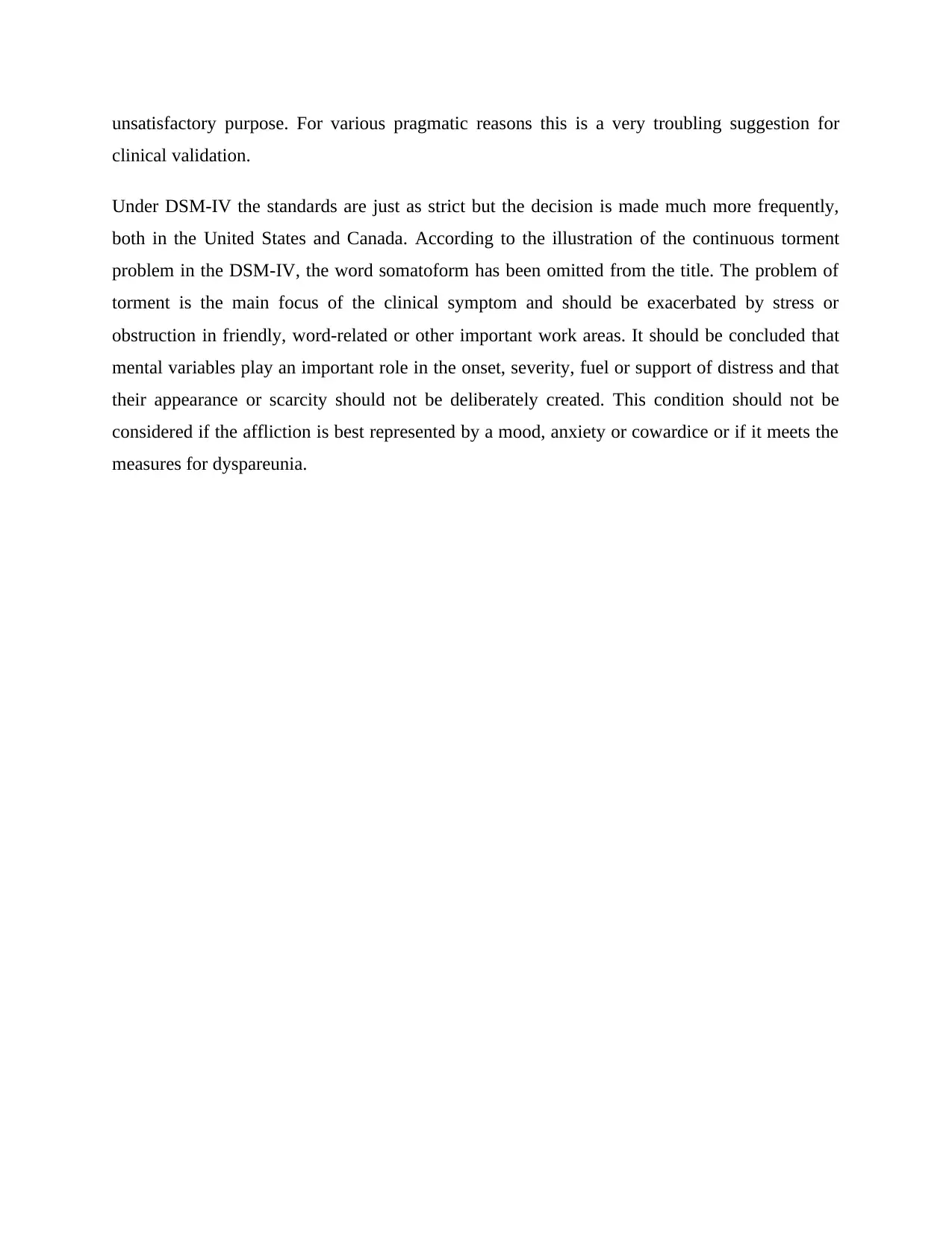
unsatisfactory purpose. For various pragmatic reasons this is a very troubling suggestion for
clinical validation.
Under DSM-IV the standards are just as strict but the decision is made much more frequently,
both in the United States and Canada. According to the illustration of the continuous torment
problem in the DSM-IV, the word somatoform has been omitted from the title. The problem of
torment is the main focus of the clinical symptom and should be exacerbated by stress or
obstruction in friendly, word-related or other important work areas. It should be concluded that
mental variables play an important role in the onset, severity, fuel or support of distress and that
their appearance or scarcity should not be deliberately created. This condition should not be
considered if the affliction is best represented by a mood, anxiety or cowardice or if it meets the
measures for dyspareunia.
clinical validation.
Under DSM-IV the standards are just as strict but the decision is made much more frequently,
both in the United States and Canada. According to the illustration of the continuous torment
problem in the DSM-IV, the word somatoform has been omitted from the title. The problem of
torment is the main focus of the clinical symptom and should be exacerbated by stress or
obstruction in friendly, word-related or other important work areas. It should be concluded that
mental variables play an important role in the onset, severity, fuel or support of distress and that
their appearance or scarcity should not be deliberately created. This condition should not be
considered if the affliction is best represented by a mood, anxiety or cowardice or if it meets the
measures for dyspareunia.
Paraphrase This Document
Need a fresh take? Get an instant paraphrase of this document with our AI Paraphraser
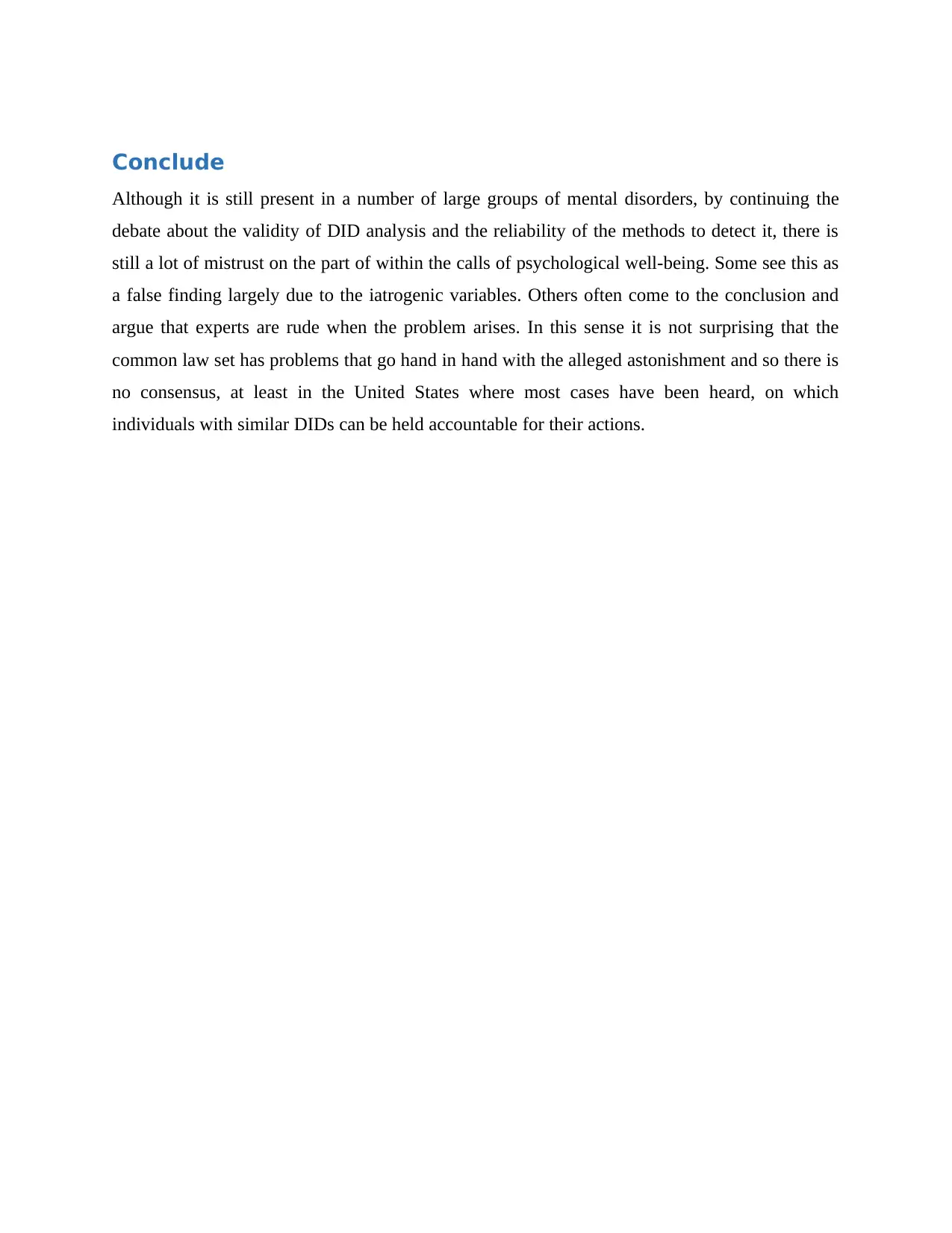
Conclude
Although it is still present in a number of large groups of mental disorders, by continuing the
debate about the validity of DID analysis and the reliability of the methods to detect it, there is
still a lot of mistrust on the part of within the calls of psychological well-being. Some see this as
a false finding largely due to the iatrogenic variables. Others often come to the conclusion and
argue that experts are rude when the problem arises. In this sense it is not surprising that the
common law set has problems that go hand in hand with the alleged astonishment and so there is
no consensus, at least in the United States where most cases have been heard, on which
individuals with similar DIDs can be held accountable for their actions.
Although it is still present in a number of large groups of mental disorders, by continuing the
debate about the validity of DID analysis and the reliability of the methods to detect it, there is
still a lot of mistrust on the part of within the calls of psychological well-being. Some see this as
a false finding largely due to the iatrogenic variables. Others often come to the conclusion and
argue that experts are rude when the problem arises. In this sense it is not surprising that the
common law set has problems that go hand in hand with the alleged astonishment and so there is
no consensus, at least in the United States where most cases have been heard, on which
individuals with similar DIDs can be held accountable for their actions.
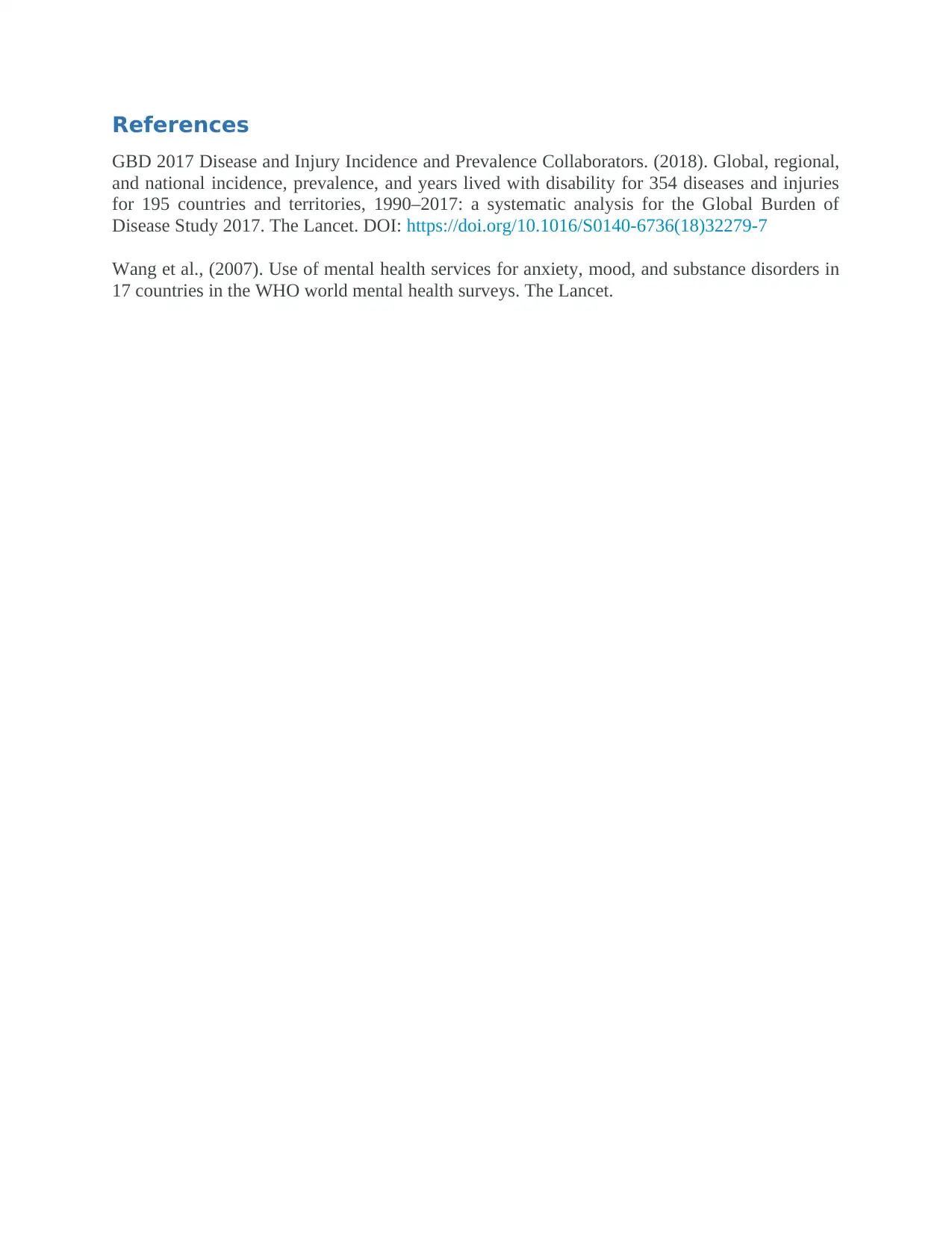
References
GBD 2017 Disease and Injury Incidence and Prevalence Collaborators. (2018). Global, regional,
and national incidence, prevalence, and years lived with disability for 354 diseases and injuries
for 195 countries and territories, 1990–2017: a systematic analysis for the Global Burden of
Disease Study 2017. The Lancet. DOI: https://doi.org/10.1016/S0140-6736(18)32279-7
Wang et al., (2007). Use of mental health services for anxiety, mood, and substance disorders in
17 countries in the WHO world mental health surveys. The Lancet.
GBD 2017 Disease and Injury Incidence and Prevalence Collaborators. (2018). Global, regional,
and national incidence, prevalence, and years lived with disability for 354 diseases and injuries
for 195 countries and territories, 1990–2017: a systematic analysis for the Global Burden of
Disease Study 2017. The Lancet. DOI: https://doi.org/10.1016/S0140-6736(18)32279-7
Wang et al., (2007). Use of mental health services for anxiety, mood, and substance disorders in
17 countries in the WHO world mental health surveys. The Lancet.
⊘ This is a preview!⊘
Do you want full access?
Subscribe today to unlock all pages.

Trusted by 1+ million students worldwide
1 out of 12
Related Documents
Your All-in-One AI-Powered Toolkit for Academic Success.
+13062052269
info@desklib.com
Available 24*7 on WhatsApp / Email
![[object Object]](/_next/static/media/star-bottom.7253800d.svg)
Unlock your academic potential
Copyright © 2020–2025 A2Z Services. All Rights Reserved. Developed and managed by ZUCOL.




